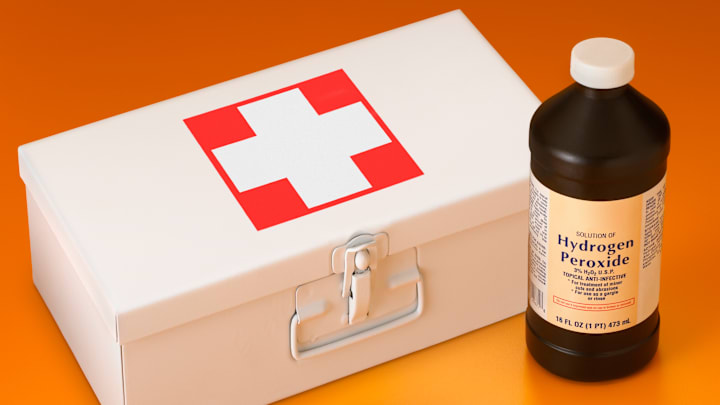Nestled between mostly white and orange bottles in your medicine cabinet, that brown bottle of hydrogen peroxide probably looks like it came from an old-fashioned apothecary. But its peculiar packaging isn’t for tradition’s sake.
The chemical formula of a hydrogen peroxide molecule is H2O2: two hydrogen atoms and two oxygen atoms. This isn’t too far off from water—H2O—and, in fact, most of the liquid in every store-bought container of hydrogen peroxide actually is just water. If it’s labeled 3 percent, that means it’s 3 percent hydrogen peroxide and 97 percent water. Other common concentrations include 6 percent and 35 percent, though they’re more often used in laboratory and food manufacturing settings than households.
Hydrogen peroxide’s double dose of oxygen gives it the power to kill bacteria and bleach surfaces, which makes it an effective cleaning solution and stain remover. (Health professionals generally don’t recommend it for wounds anymore.) But as peroxide provider Bulk Peroxide explains, it doesn’t take much to break the bond holding the molecule together—like exposure to light or heat. Storing hydrogen peroxide in an opaque brown bottle prevents light rays from penetrating its contents.
But if you transferred your hydrogen peroxide into a more aesthetically pleasing clear container, don’t worry. The decomposition of hydrogen peroxide isn’t dangerous, and it can happen eventually even when it is stored properly.
“The extra oxygen breaks down over time,” physician Sarah Pickering Beers told Cleveland Clinic’s Health Essentials. “Once it loses its bubbles, you’re basically left with water.” If there’s no sign of foam when you apply hydrogen peroxide to a surface, it may no longer be hydrogen peroxide. And if you like to keep it in a spray bottle for ease of cleaning, it’s best to invest in a dark, opaque one.
